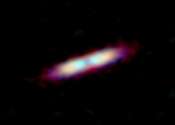What's in a flame? The surprising mystery of how soot forms
Soot is one of the world's worst contributors to climate change. Its impact is similar to global methane emissions and is second only to carbon dioxide in its destructive potential. This is because soot particles absorb solar ...









